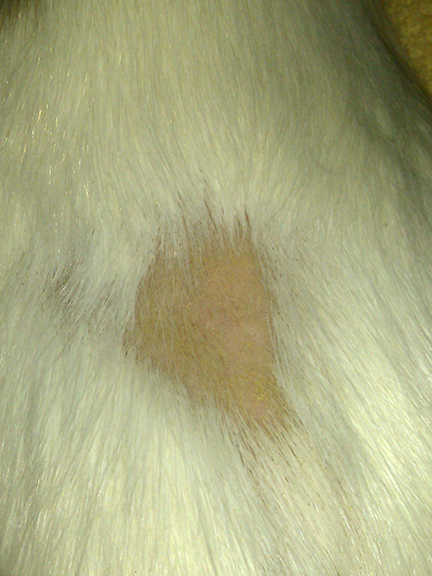When my sisters recently gave me a guinea pig, Millie, she had a bald spot on her back but no other bald spots. It’s almost in the shape of a heart. There are some short hairs and some flakey yellow skin when you scratch at it. She doesn’t seem to mind it. I’ve attached some pictures if that helps. Thank you.
Probably 90% of the young guinea pigs that I see in my practice with these signs test positive for lice, mites, fleas, or ringworm. It is always important to practice good hygiene when handling a small mammal, however, these parasites are species-specific, and so they typically do not remain on humans or other animals that come in contact with the affected guinea pig. Less common causes include dermatitis caused by vitamin C deficiency, allergies, over-productive glandular tissue (typically males), and other primary skin disorders. Examination and some basic testing is recommended to identify and treat the cause.
Identification of the parasite usually requires a test called a skin scraping. A sample of skin is gently scraped and the collected material is examined under a microscope. In the case of lice, sometimes it is possible to see the parasites or their eggs with the naked eye or by using a piece of scotch tape to pull some hairs for microscopic examination. Fleas can be found using a special “flea comb,” which has fine teeth that catch the fleas as you run the comb deeply through the pet’s fur.
If parasites are diagnosed, there are many treatment options including powders, medicated baths and dips, topical pesticides (such as Revolution®), and injectable pesticides. My preference for mite and lice infestations is Revolution® because it is easy to apply and relatively safe and easy for the patient to tolerate. Treatments of the cage, frequent bedding changes, and follow-up doses of the pesticide are usually required depending on the parasite in question. All in-contact guinea pigs must be simultaneously treated to prevent reinfection. Ringworm and other causes require different therapy.
One last comment. Guinea pigs are one of the few species that cannot manufacture their own vitamin C from other nutrients, and therefore have an absolute vitamin C requirement in their diet (about 50mg/day). This can be achieved with high vitamin C fresh foods (for a list, see my guinea pig care sheet at www.catandexoticcare.com under the references section), or vitamin C supplementation in the way of fortified pellets or tablets. The vitamin C that is administered in water is not recommended since it rapidly degrades and may even prevent a guinea pig from drinking enough. Most commercial guinea pig diets have vitamin C built in, but it degrades within 90 days after the food is milled, so it is best not to rely on the pellets alone.

Max Conn, DVM is the owner of Cat & Exotic Care of the Central Coast, a full-service veterinary hospital, open Monday through Saturday 8 a.m. – 5:30 p.m, dedicated to the special needs of cats, birds, reptiles and small mammals. Cat & Exotic Care is located in Pismo Coast Plaza, 565 Five Cities Drive, 805-773-0228. More information can be found at www.catandexoticcare.com.
If you have a veterinary question that you would like to propose for an upcoming edition, please send it to email@catandexoticcare.com with “ask the vet” in the subject line.

